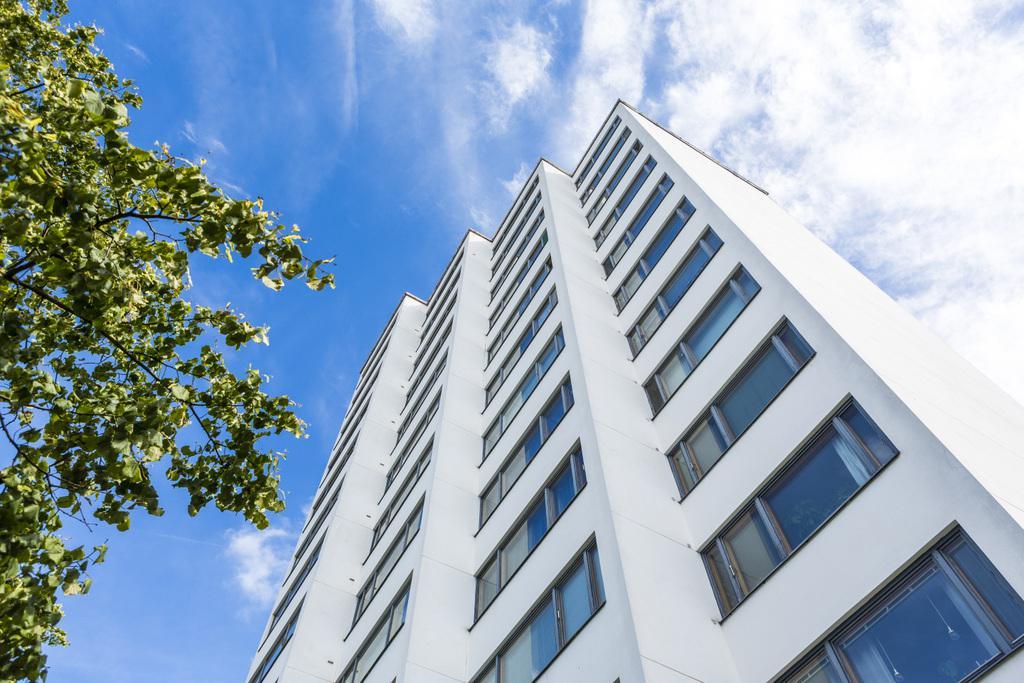
Duration: 2 hours
Length: 6,8 km
In total, there are nearly 30 buildings designed by Alvar Aalto in the Jyväskylä region – ranging from his earliest work to designs made during his final stages. These include both private properties and public buildings, such as the Jyväskylä City Theatre, the University campus and AaltoAlvari Aquatic Centre. Alvar Aalto bicycle tour lets you see the center of Jyväskylä, while showing off the architecture of Alvar Aalto in different city districts.
Currently, Jyväskylä is known as a city of sports, and the region offers varied bicycle and hiking trails for people of all skill levels. What better way to see the works of the renowned architect than a bicycle tour? The beautiful lake landscape colors the hilly terrain, and the region offers a number of bicycle and hiking trails popular among the locals.
Our Alvar Aalto bicycle tour lets you see the center of Jyväskylä, while showing off the architecture of Alvar Aalto in different city districts. The bicycle tour starts at the Aalto2 -museum center (number 1 on the map), continuing to the center of Jyväskylä and towards the lake landscapes of Taulumäki and Viitaniemi. The tour then returns to the city center, visiting the University of Jyväskylä, one of the most architecturally interesting campus areas in Finland.
Route description
- Aalto2 Museum Centre
Alvar Aallon katu 7, 40600 Jyväskylä
- Casa Laurén 1925–1928
Vapaudenkatu 12, 40100 Jyväskylä
- Jyväskylä Administrative and Cultural centre 1964–1982
Vapaudenkatu-Kilpisenkatu-Hannikaisenkatu-Gummeruksenkatu, 40100 Jyväskylä
- Defence Corps Building 1926–1929
Kilpisenkatu 8, 40100 Jyväskylä
- Nikolainkulma
Vapaudenkatu 53, 40100 Jyväskylä
- Workers’ Club 1924–1925
Väinönkatu 7, 40100 Jyväskylä (At the intersection of Väinönkatu and Kauppakatu)
- Renovation of Nuora House 1923–1924
Hongikontie 9, 40200 Jyväskylä
- Viitatorni 1957–1962
Viitaniementie 16, 40720 Jyväskylä
- Aira House 1924–1926
Tapionkatu 2, 40100 Jyväskylä
- Jyväskylä University Seminaarinmäki Campus 1951–1971
Seminaarinkatu 15, 40100 Jyväskylä
- Villa Karpio 1923
Lehtisenkuja 1, 40600 Jyväskylä
Route on Google Maps
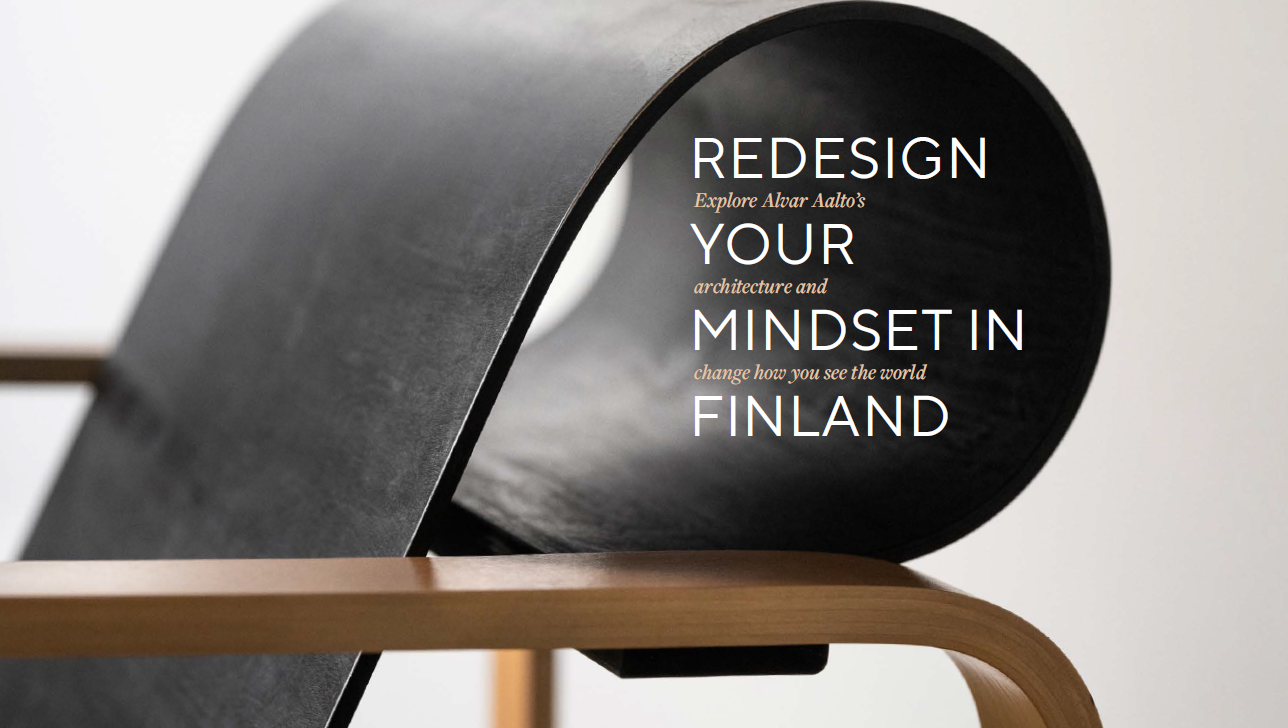
Welcome to the Alvar Aalto Route – a journey where the magic of architecture and design comes alive, inviting you to see the world through a redesigned lens. Alvar Aalto (1898–1976), the visionary of modern architecture, shaped spaces with a profoundly human approach. His creations are more than buildings; they are experiences that resonate with the soul. Scattered across Finland and beyond, they serve as gateways to a reimagined world.
In 2021, this extraordinary route was honoured with the prestigious certification as a Cultural Route of the Council of Europe, affirming its role in the rich tapestry of European heritage. The Alvar Aalto Route offers more than a journey through architectural masterpieces—it extends a warm invitation to immerse yourself in a space where design, nature, and the human spirit converge in harmony.
This catalogue is your guide to a curated collection of Aalto experiences. Each package is a thoughtfully designed adventure into Alvar Aalto’s world, seamlessly blending his iconic architecture with the unique flavours of local life. From serene Finnish landscapes to vibrant European Aalto destinations, these journeys offer something for everyone. Whether you’re a first-time visitor or a devoted admirer of Aalto’s work, we warmly welcome you—and continually seek new partners to enrich the experience.
Step into spaces that defy the ordinary, where every curve, every material, and every detail tells a story that redefines how you perceive the world around you. This is the essence of the Alvar Aalto Route: an invitation to rediscover beauty, functionality, and the interconnectedness of life through the lens of one of modern architecture’s greatest minds.
Let us help you navigate this adventure and uncover how Aalto’s vision can transform not just physical spaces but also the way you view the world itself.
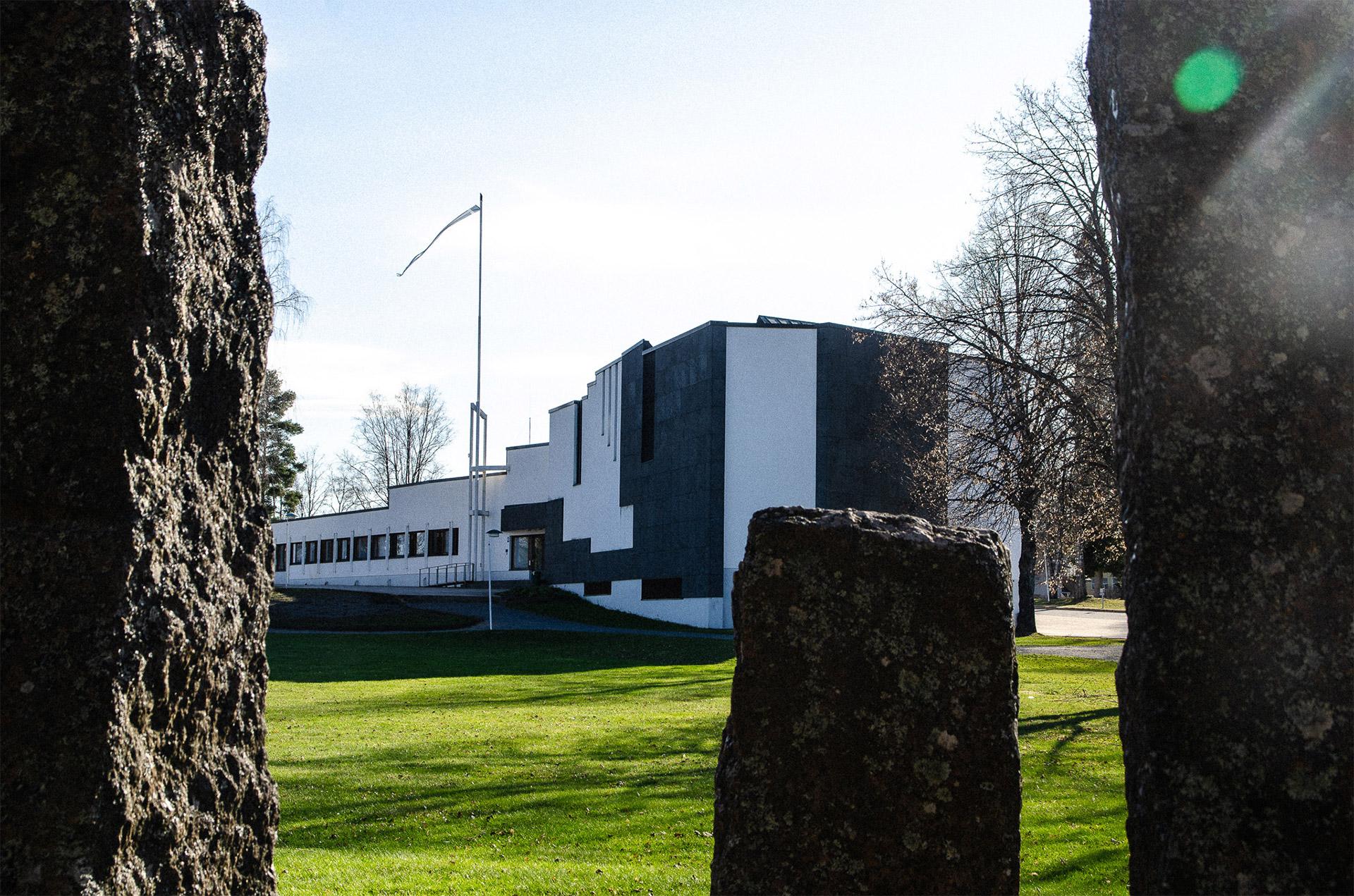
Among the Aalto sites in Alajärvi, the town hall is the largest and most prominent. The building’s facade is dominated by the large windows of the council chamber and the minimalist white walls. Construction of the Alajärvi town hall began in 1966 and it was completed a year later. The most impressive parts of the terrain-adaptive office building are the lobby and the council chamber. The council chamber is taller than the rest of the building and is adorned with windows of various sizes and shapes that let in the rays of the morning and evening sun.
Alvar Aalto approached his buildings as total works of art, where furniture and lighting were also important elements of the design. In the council chamber of the Alajärvi town hall, there are furnishings, tables, chairs, and lamps designed by Aalto, as well as seating in the foyer.
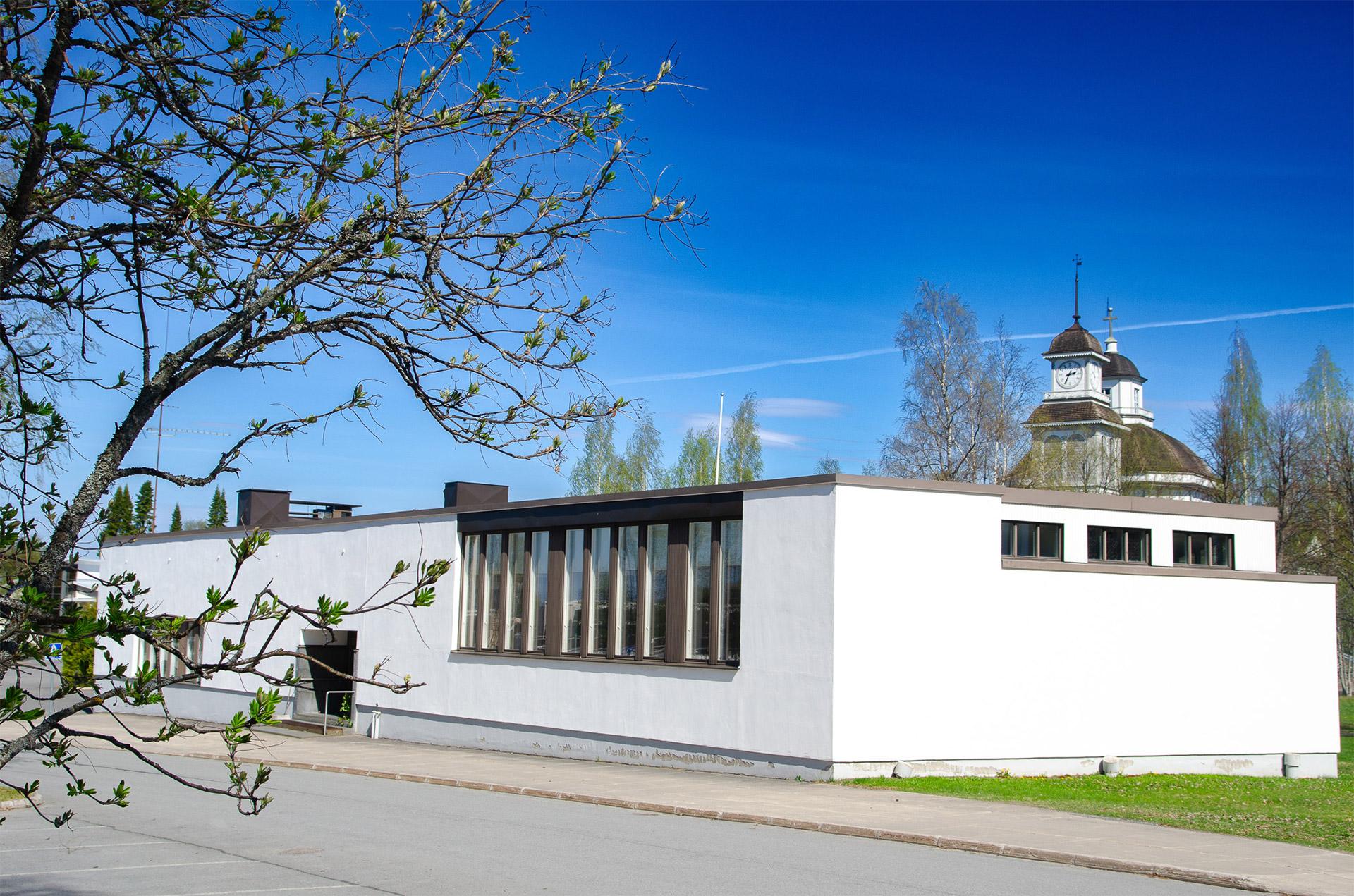
Construction of the parish hall began in 1969 and it was completed a year later. The Japanese-influenced parish hall features a lot of open, bright, and unified space. The parish hall’s minimalist white style echoes other buildings in the Aalto Center, such as the town hall and the library. The Aalto Center comprises several buildings by Aalto, all within a short walking distance from each other. Together, the buildings of the Aalto Center form a unique ensemble.
Inside the parish hall, there is a lot of open space. Aalto’s interest in Japanese culture and architecture is evident in the interior aesthetics of the parish hall. The minimalist appearance of both the interior and exterior of the parish hall contrasts with the Alajärvi Church, designed by Carl Ludwig Engel, located behind the building. Although the styles of the buildings are completely different, their color schemes are similar.
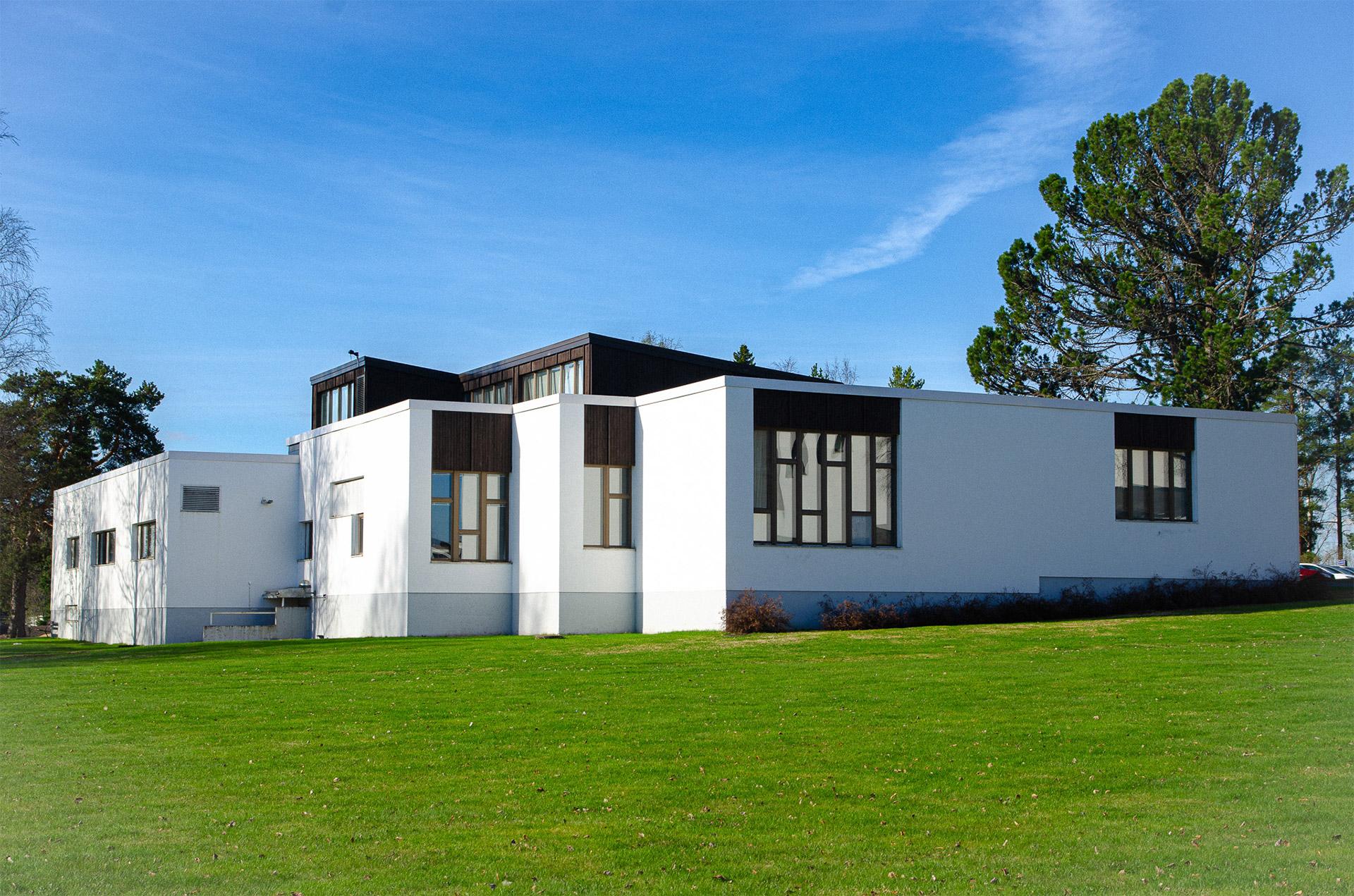
The Alajärvi City Library is the last design project by the architectural firm Aalto & Co. The library was completed in 1991, with Heikki Tarkka serving as the chief architect. Elissa Aalto, Alvar Aalto’s spouse, who finalized several of Alvar Aalto’s unfinished buildings, also participated in the design work. In 1966, Alvar Aalto created a plan for an administrative center in Alajärvi, and the library building’s design is based on his site plan and model.
The library’s minimalist white style echoes other buildings in the Alajärvi Aalto Center, such as the town hall and the parish hall. The Aalto Center comprises several buildings by Aalto, all within a short walking distance from each other. The most striking feature of the library’s design is the undulating wooden ceiling panel. The different shades of wood, the wavy lines, and the spaciousness of the library hall create an organic and nature-inspired impression of the building.
In addition to library operations, the building also hosts rotating art exhibitions.
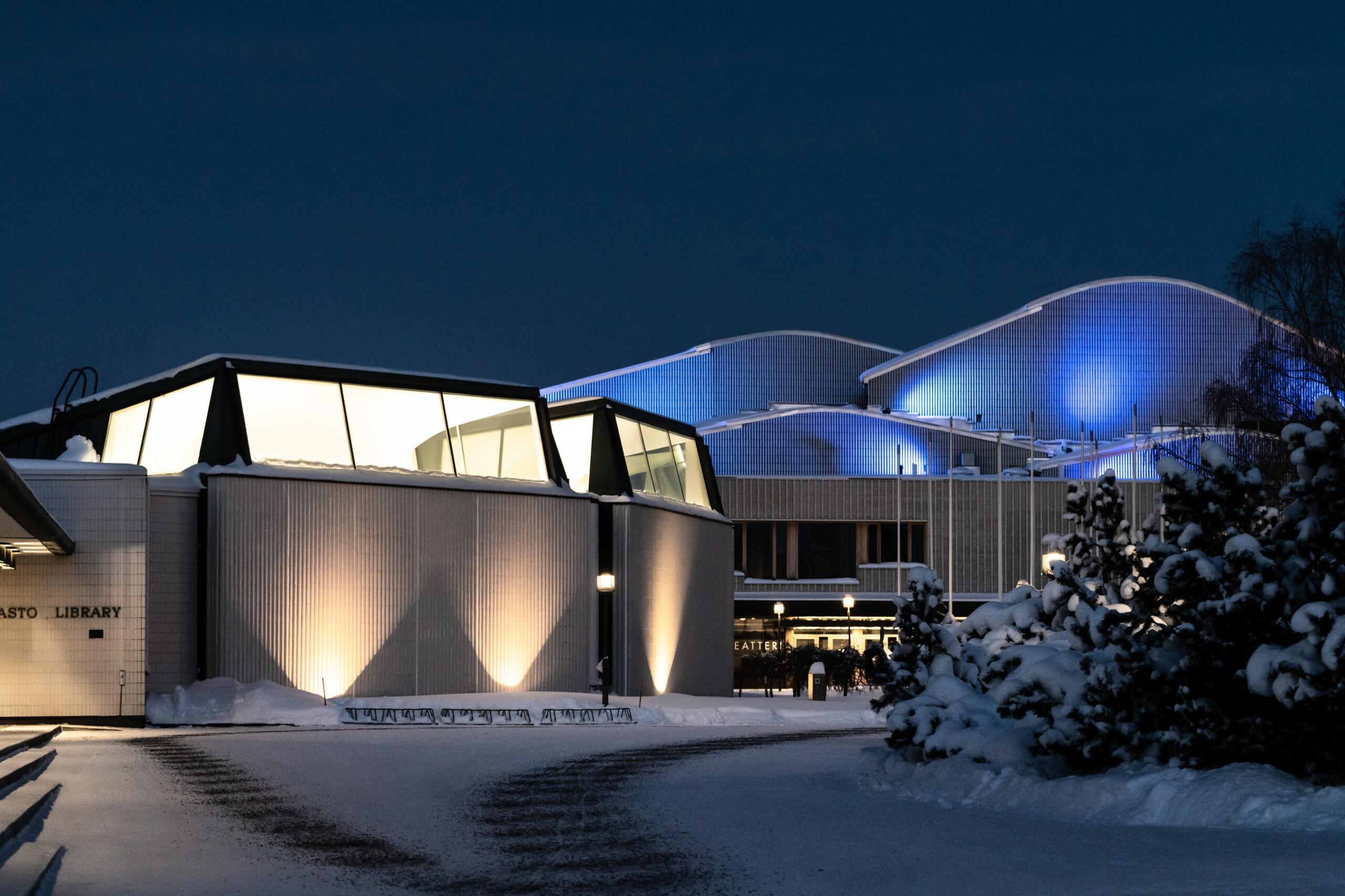
The Rovaniemi administrative and cultural center, Aalto center, is the only completed city center in Finland by Alvar Aalto, along with Seinäjoki.
The three buildings of the Aalto center – the library, Lappia Hall and the town hall – open like a fan shape towards the city center in a spacious park-like square. The library was the first to be completed in 1965. Lappia Hall was the last building that Alvar Aalto saw completed before his death. It was completed in two stages in 1972 and 1975. The design work of the town hall, completed in 1986, was led in Aalto’s office by his wife, architect Elissa Aalto.
The architectural highlights of the buildings are placed on the side of the square, where they form a spectacular entity. The upper windows of the library rise visibly from the rhythmically folded closed facade and bring natural light to the lending department. The upper parts of the stage halls of Lappia Hall rise like fells above the sleek facade line. In the town hall the council chamber has been formed like a crystalline tower, taller than the rest of the building.
In addition to the recognizable features of Aalto’s architecture, the buildings are bound together by the facade materials – light brick and ceramic tile. The materials for the interior of the buildings are well thought out, as are the furniture and lighting, which are partly from Artek’s collection, partly designed for the buildings by Aalto’s office.
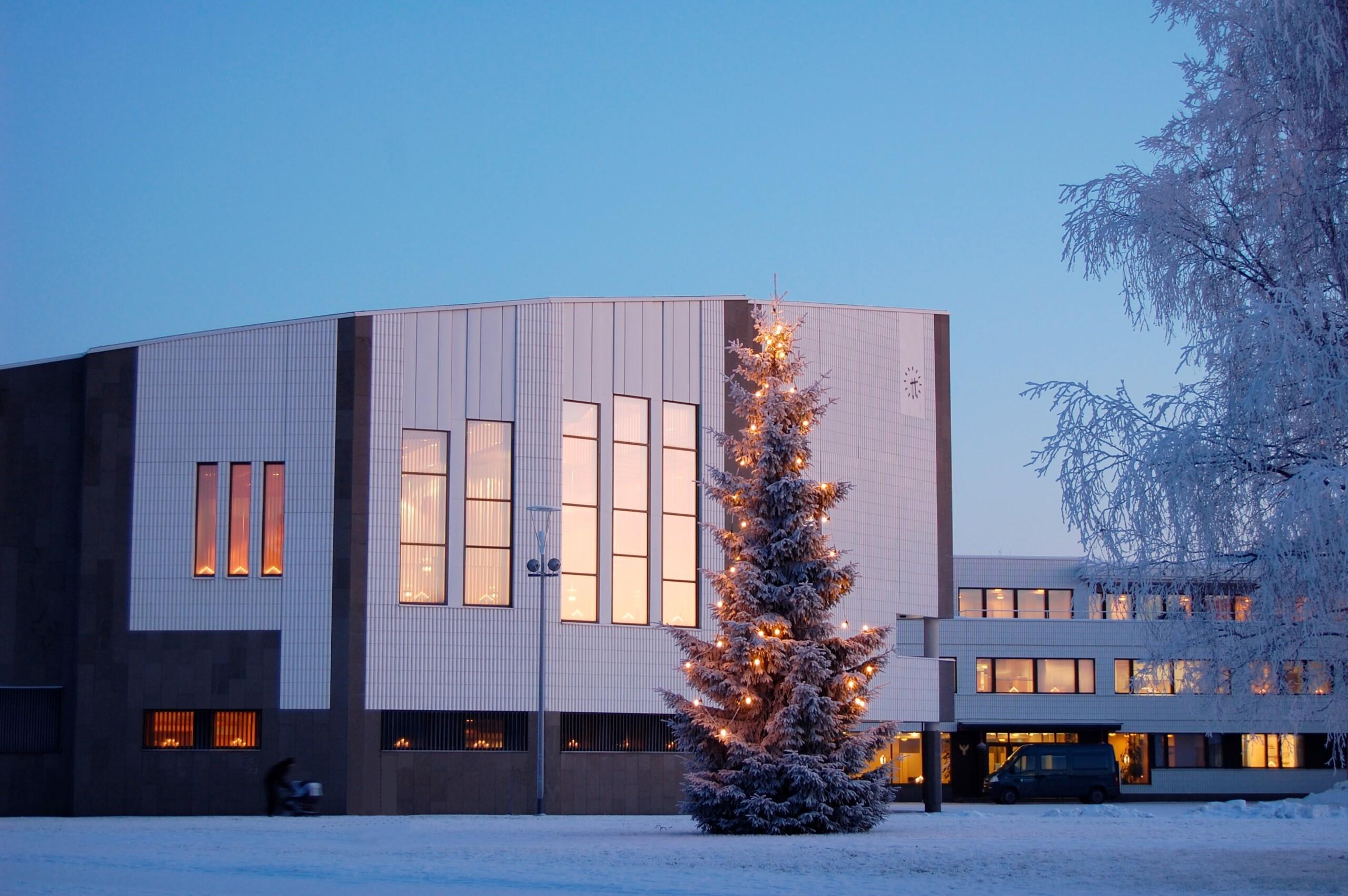
The completion of the City Hall in 1986 completed Rovaniemi’s administrative and cultural center, the Aalto Center. Along with Seinäjoki, it is Alvar Aalto’s only completed civic center in Finland. The City Hall was designed based on Alvar Aalto’s sketches after his death under the direction of Elissa Aalto.
The building complex consists of several wings in different directions, which are dominated by the council hall with its sculptural tower part. In connection with the main entrance of the building, are the most important facilities of the town hall, such as the council hall, meeting rooms and the mayor’s room. In particular, the crystalline council hall stands out from the building complex as a tower higher than the rest of the building.
Like in the other buildings of Aalto Center, the interior of the City Hall consists, for example, of Lapland marble and natural-colored wood. The City Hall’s furniture and lighting are partly Artek’s production and partly designed for the building by Aalto’s office.
Kain Tapper’s environmental artwork “Birth of the Mountains” was placed in the square of the Aalto Center after the completion of the town hall in 1988.
Rovaniemi City Hall is closed for the time being due to renovations that are scheduled to be completed in 2026.
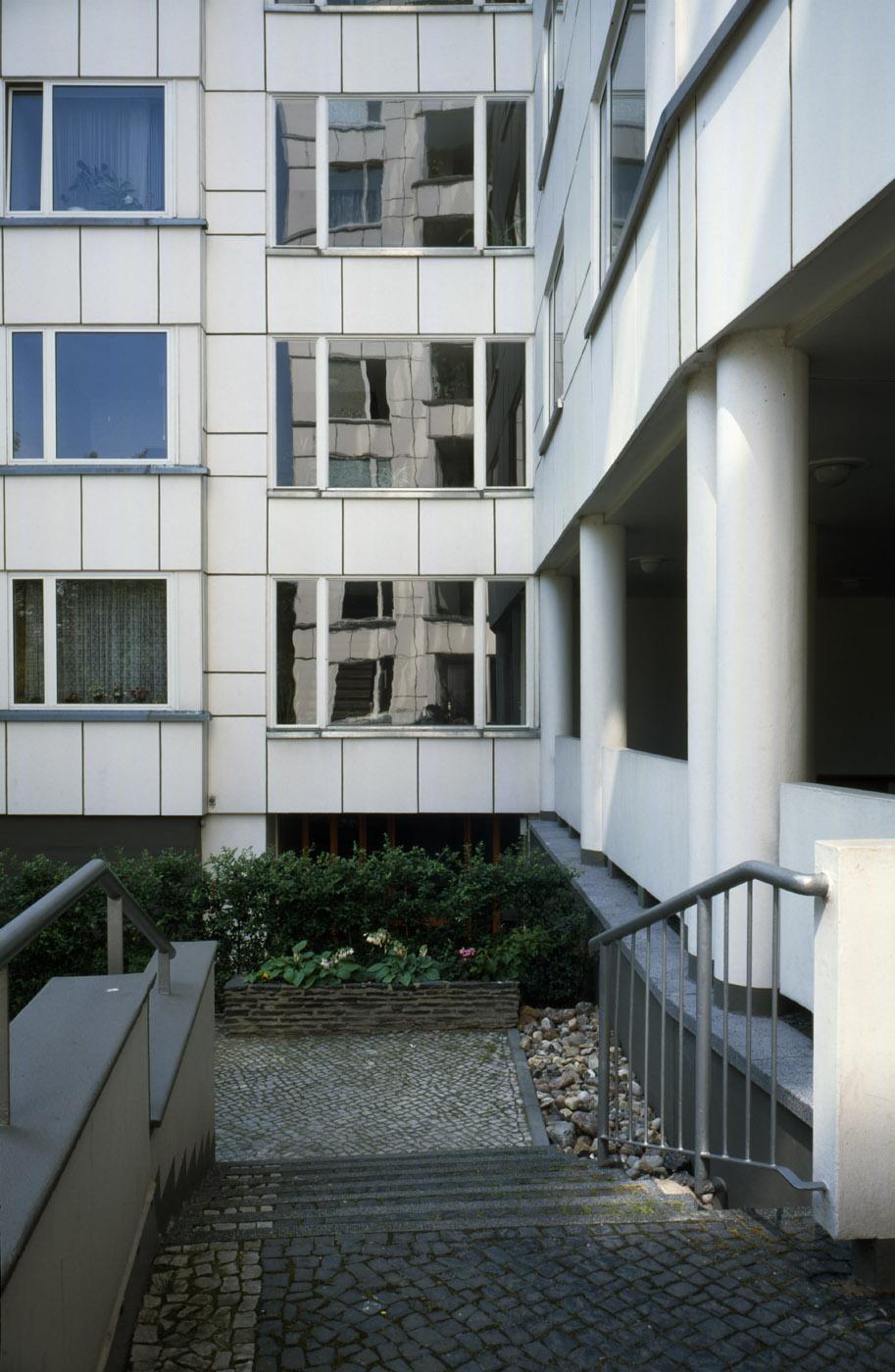
Take part on a three-day tour, where you get to spend two days in Berlin and one in Wolfsburg. On this tour you can admire and get to know the architecture, landscapes and sights accompanied by an exclusive English-speaking guide. During the tour, you will also get to experience a few interesting buildings that Alvar Aalto designed in Germany.
The tour begins by exploring Berlin, a city where there is definitely plenty to see and do. The first two days of the program provide an in-depth tour of the city’s interesting architecture and attractions. You will also get to enjoy the exciting atmosphere of the city and also do some shopping while you are at it. After taking over Berlin, the tour continues on a day trip towards the city of Wolfsburg, which has a lot to offer in particular for Aalto enthuastictics.
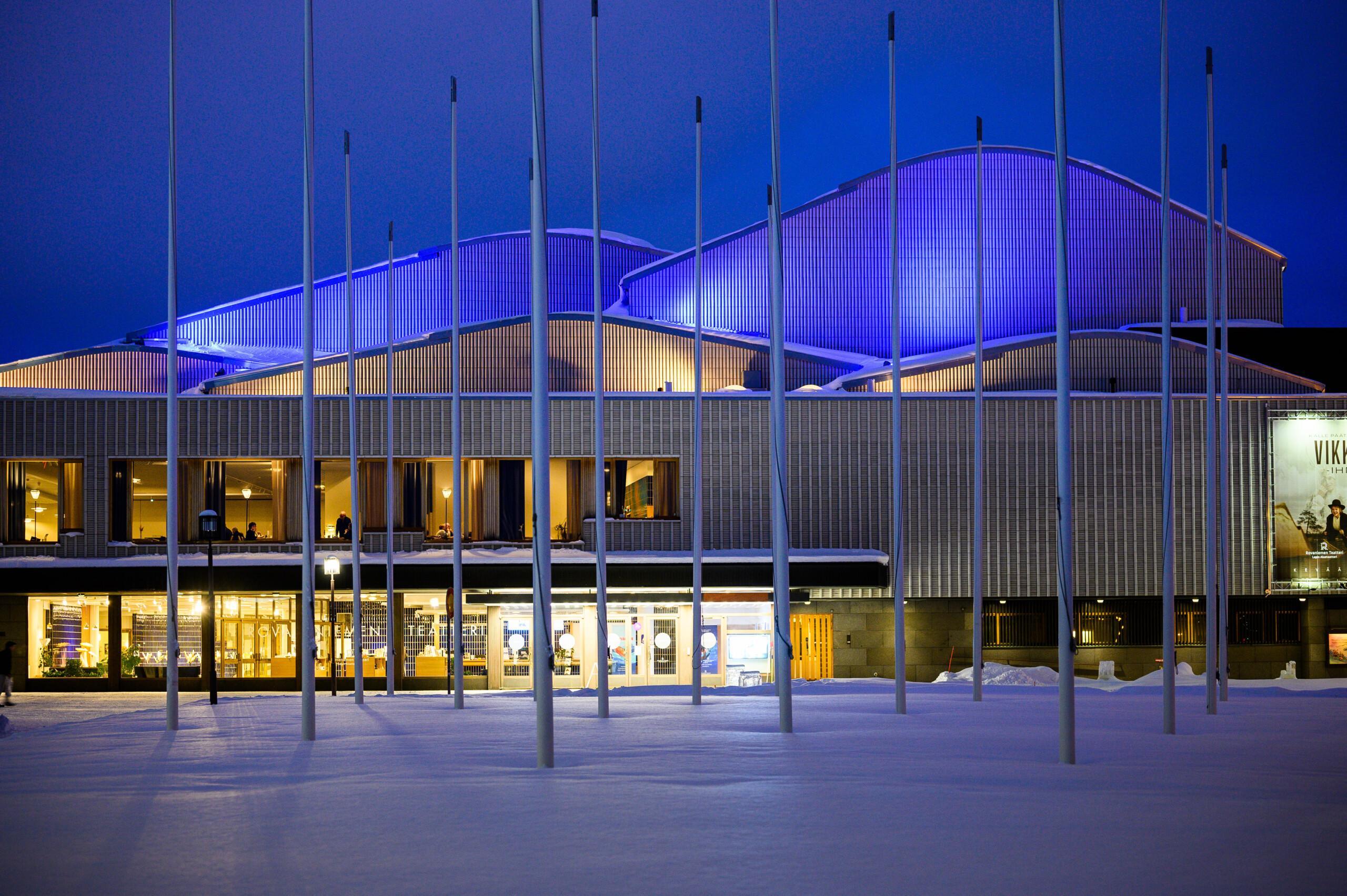
Lappia Hall is part of the Rovaniemi administrative and cultural center, the Aalto Center, designed by Alvar Aalto. The building is a well-known landmark of Rovaniemi. Lappia Hall was built in two parts. The first part, including the music school, was completed in 1972, and the main part of the building used by the theater in 1975. Lappia Hall was the last building that Alvar Aalto saw completed before his death.
The undulating roof structure of the building resembles the fell landscape of Lapland. The curved shapes of the roof are illuminated in different colors, and in its evening outfit Lappia Hall is a particularly magnificent sight. Lappia Hall is a total work of art characteristic of the Aaltos. Aalto’s office designed not only the building but also the interior and furniture. From the outside, the building is finished with light rod-shaped ceramic tiles.
The floor surfaces of the interior of the building are covered with Lapland marble and the interior walls are decorated with dark shiny cobalt rod-shaped ceramic tiles. The unique architecture of Lappia Hall is specially designed for the use of cultural actors. The Rovaniemi Theatre / Lapland Regional Theatre, the Lapland Music and Dance Institute and the Rovaniemi School of Visual Arts currently operate in the building. Over the years, Lapland’s regional radio and Lapland’s regional museum have also operated there. The comprehensive renovation of the building was completed in 2015.
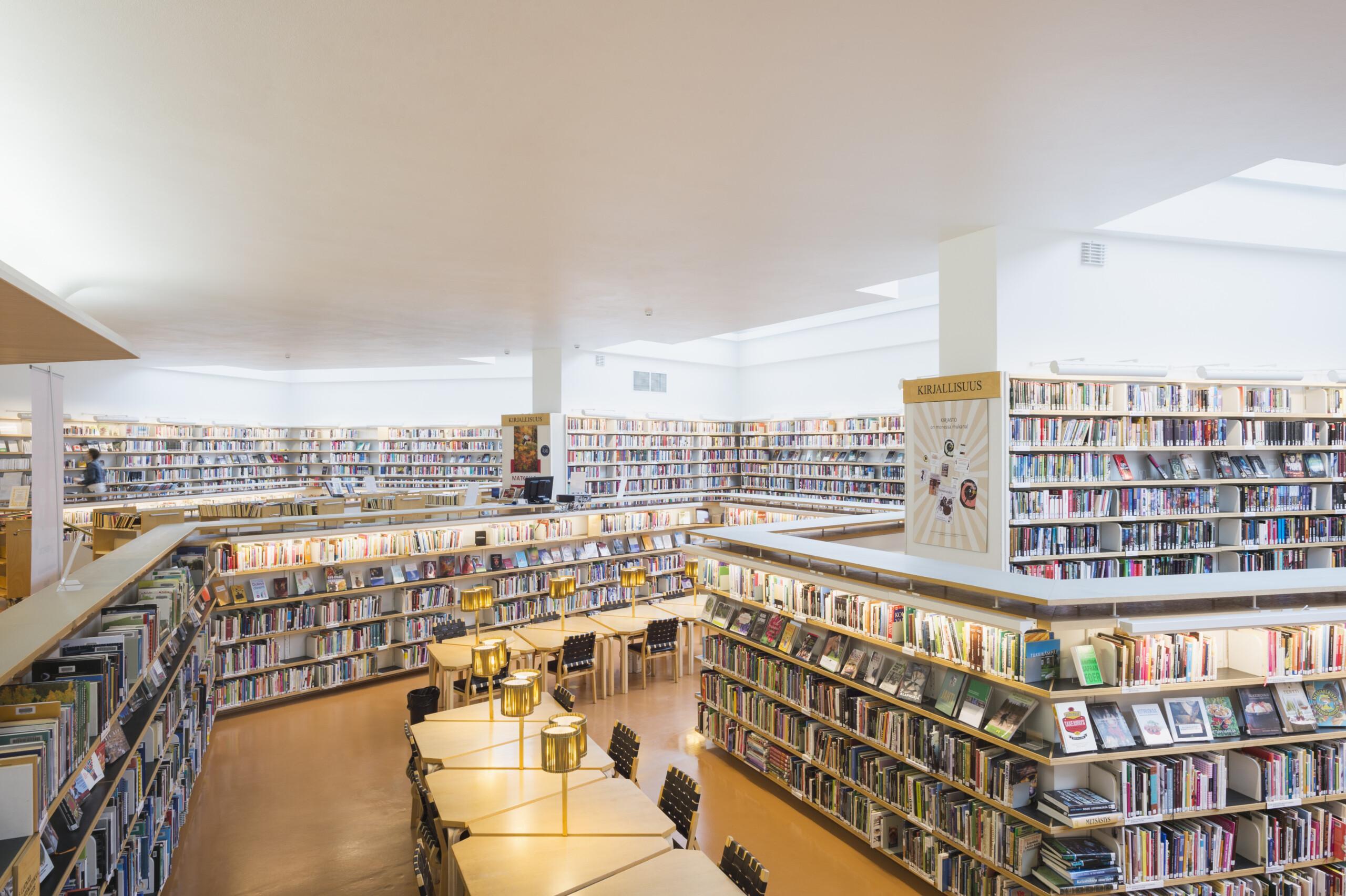
The library building, which was completed in 1965, was the first of the Rovaniemi administrative and cultural center buildings.
The Rovaniemi library consists of two connected parts: a fan-shaped library hall and an elongated, rectangular office wing. The interior design of the library followed the idea typical of Aalto’s libraries, where the library’s reading rooms were placed on a lower level than the rest of the library hall, in their own recesses. The goal of the hall’s fan-like shape is to enable the staff to have an unobstructed view of the entire hall. In addition to the library hall, the building contains, among other things, a music library, magazine rooms, an exhibition and auditorium hall, and a children’s section.
Natural light and lighting played an important role in the library’s plans. Indirect natural light is brought into the premises by various upper and roof windows and an exceptionally wide variety of fixed special lamps. This creates a great atmosphere in the building in the changing northern light, from dark winters to nightless nights in summer. Some of the furniture and lighting in the library are Artek’s standard models, but Aalto’s office also designed special furniture and at least 10 different lighting models for the building.
The Rovaniemi library is closed for the time being due to renovations that are scheduled to be completed in the summer of 2025.
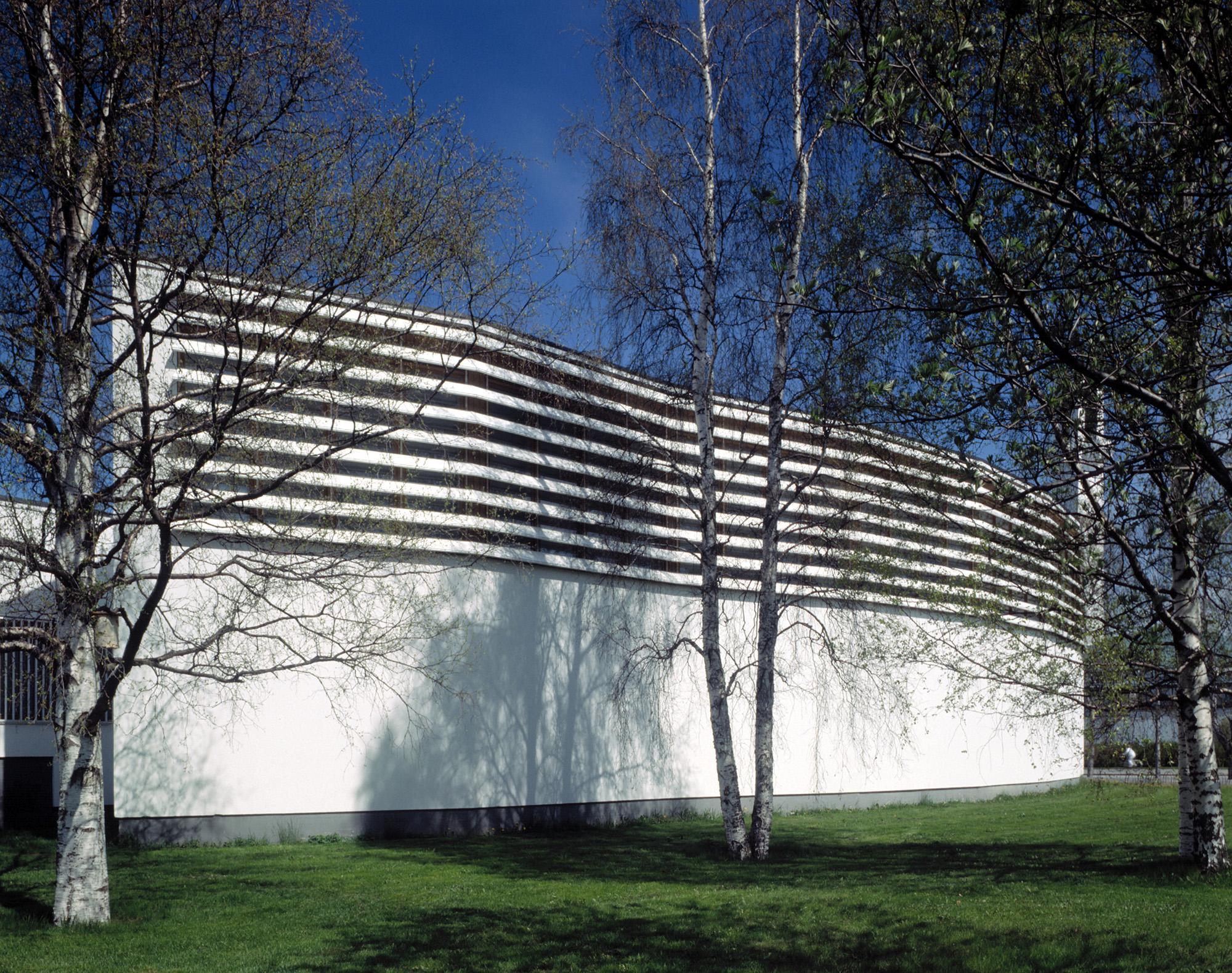
The Seinäjoki Library was designed as a part of the Aalto Centre in Seinäjoki and the building completed in 1965. Originally the public and other working spaces were mainly located on the ground floor of the building whereas storage and exhibition spaces were located downstairs. Aalto also designed the main part of the built in fixtures, furniture and light fixtures as a part of the entity of the building.
Aalto’s library functioned as the main library of the city until 2012. In 2012 the new main library Apila was completed and Aalto’s library was connected to it with a under ground passage. Aalto’s library was renovated to its original state during 2012-2015. The renovation was considered to be a great success and an example to other renovation projects. Also the furniture and the lighting for the reading room were restored during the renovation and were then installed in their original locations. Nowadays the regional collections, genealogy and a separate children’s literature department operate in the library. Arts, architecture, history and ethnology literature is also placed in Aalto’s library.
Aalto’s Seinäjoki library also has an important collection of design glass by Aino and Alvar Aalto on display in the library’s original magazine reading room. The collection is owned by the city of Seinäjoki.
Aalto’s Seinäjoki library has a very simplified façade and the strips of windows that are covered with slats dominate it. It is considered to represent a free-form hall library type. A lot of attention was given to the lighting of the building and especially in capitalizing the natural daylight. The lending desk is located right in the middle of the building. Behind it Aalto designed a lowered reading space which is a typical feature in Aalto’s libraries. The layout of the building combines forms of a rectangle and a fan, which also plays an important role in the surveillance of the building.
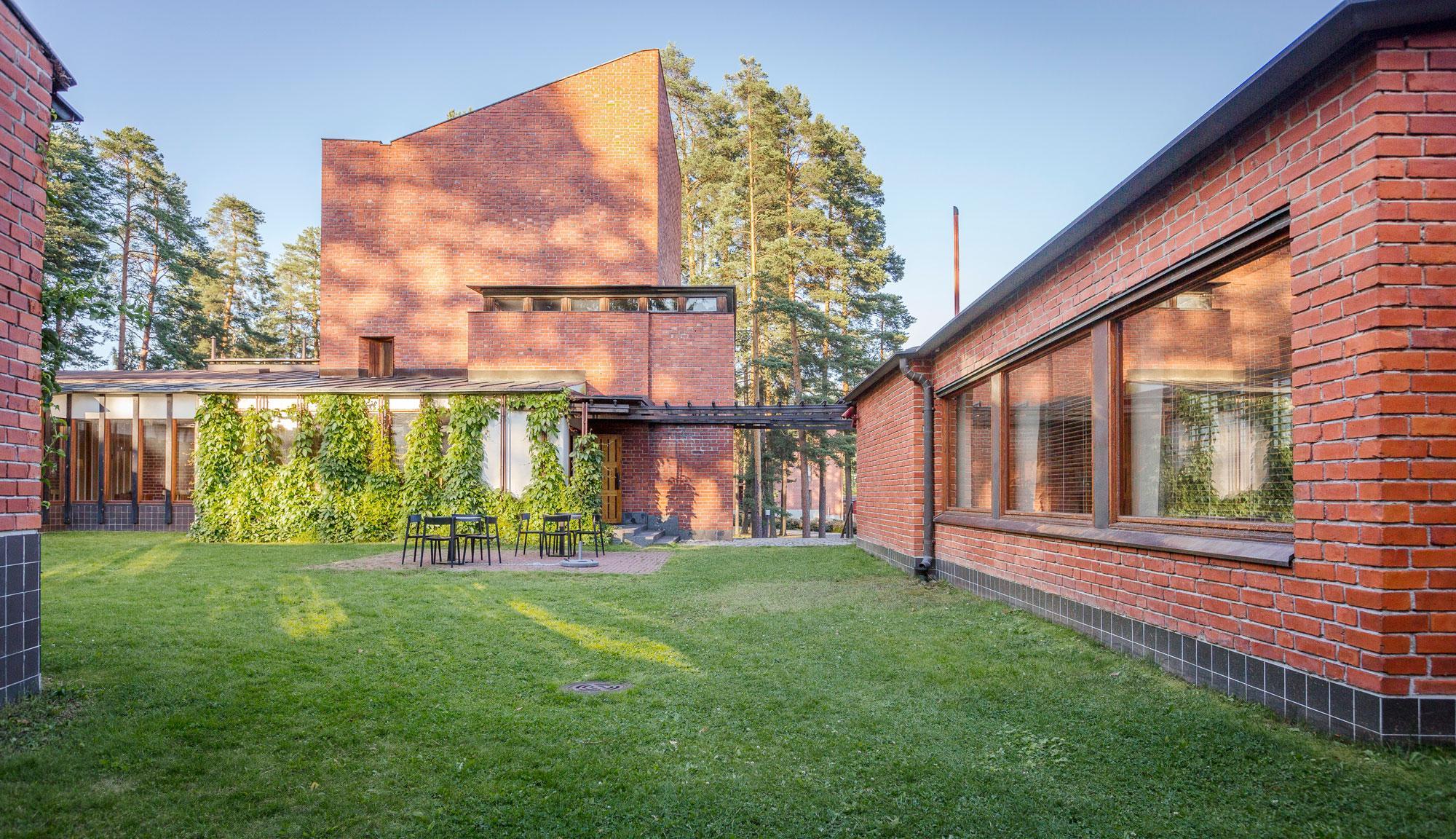
Travel in the sceneries from the various phases in the life of Alvar Aalto, from Seinäjoki via Kuortane and Alajärvi to Jyväskylä in the lake district of Finland. See the master’s birthplace and family grave, some of his most famous competition works as well as his early and later works.
Alvar Aalto designed a world-famous centre of administrative and cultural buildings in Seinäjoki. The landmark of the Aalto centre, the Cross of the Plains Church, soars to a height of approx. 65 metres. The renovated Aalto Library exhibits the world’s biggest private collection of Aalto glassware.
The architect was born in Kuortane and he used to spend his summers in Alajärvi, which is the home for the first buildings designed by the young architect student and for the last creation of Aalto’s office. In Alajärvi, the tour participants can also visit the recently renovated Villa Väinölä, the house that Alvar Aalto designed for his brother. The countryside provided Alvar Aalto with a setting for relaxation during his hectic creative period.
The Jyväskylä region contains more buildings designed by the master architect than any other region in the entire world. Among as many as 28 attractions, you can choose for example the Alvar Aalto Museum, Muurame Church and Säynätsalo Town Hall, which is considered Aalto’s most prominent work in the red brick era. Alvar Aalto also went to school, started a family and launched his prestigious career in Jyväskylä.











